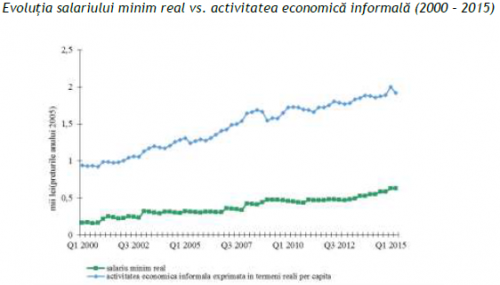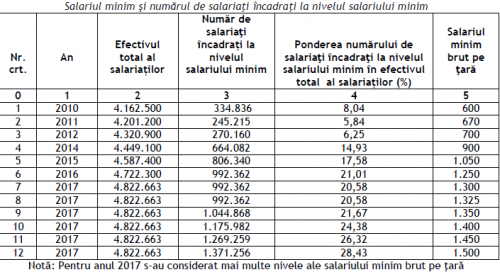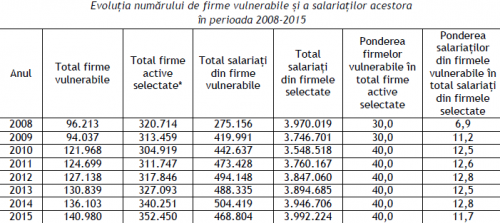 The impact of the national minimum salary on the work productivity is negative – an increase of the minimum salary by 10% would have as result a decrease of the work productivity by 2.3%, according to a study conducted for the Government by the National Scientific Research Institute for Labour and Social Protection (INCSMPS) .
The impact of the national minimum salary on the work productivity is negative – an increase of the minimum salary by 10% would have as result a decrease of the work productivity by 2.3%, according to a study conducted for the Government by the National Scientific Research Institute for Labour and Social Protection (INCSMPS) .
„It seems that the increase of costs in Romania – caused by raising the minimum wage – is not counterbalanced by increased productivity,” is the conclusion of the study. It draws attention to the fact that „figures, although statistically valid, should be analysed cautiously because productivity might be influenced by many factors and the link between the minimum wage and productivity is not very close„, as shown in the econometric model used for the analysis.
Raising the minimum wage guaranteed for payment will not though automatically led to an increase by the same amount of the total obtainable income of the household, because many families paid with at least one such salary are also benefiting from state support (guaranteed minimum income or family support allowance).
An increase of the minimum wage will automatically cause for some of the employees being paid with the minimum amount to no longer receive money from the state as supplement to their income, as they would exceed the threshold required by law per family member.
That would reduce the number of families of employees that live in poverty and would be a small relief for the state expenditure on social assistance. According to the employer associations, that would mean transferring a small part of the social assistance burden to companies.
Romania has though the highest in-work poverty rate, according to Eurostat.
Black economy grows when the minimum wage increases
There is a relationship of „in tandem movement” between the changes in the minimum wage and the informal economy, says the study, which is seen from the analysis of the 2000 – 2015 period:
*
Evolution of the minimum real wage vs the informal economic activity (2000-2015)
*
The INCSMPS experts have identified a negative relationship, of substitution, between the two economies, formal and informal, which means that the black economy plays the buffer role (safety valve) for certain periods of time and certain categories of persons (young or low-skilled workers).
Overall, the empirical results showed that on long-term, the minimum wage has a positive and statistically significant impact on the informal economic activity in Romania, while on short term this impact is not supported by empirical evidence.
The three scenarios of increasing the minimum wage and their impact
The study includes calculations on three possible scenarios in 2017:
- freezing the minimum wage guaranteed for payment
- 10% increase of the national minimum wage
- 20% increase
The share of lowest-paid employees of the total number of employees evens out, in case of a moderate growth – from 1,250 lei to 1,300 or 1,325 lei – but the share exceeds 25% when the minimum wage exceeds 1,450 lei.
*
Minimum age and number of employees on minimum wage
Year Total number of employees Number of employees with the minimum wage Share of lowest-paid employees of the total number of employees (%) National minimum gross wage
Note: several levels of the national minimum gross wage have been considered for 2017
*
Impact on the average gross wage: All three scenarios of increasing the minimum wage show an upward trend of the average gross earnings during the period under review, but the growth pace is different.
Increasing the minimum wage does not automatically lead to proportional increases of the average wage, mentions the study.
*
Hypothesis Scenario 1 Scenario 2 Scenario 3
Minimum wage maintains at the level of 1,250 lei in 2017
Minimum wage increases by 10% (to 1,375 lei in 2017)
Minimum wage increases by 20% (to 1,500 lei in 2017)
Conclusion
Annual average growth rate of the average gross wage is of 7.32%
Annual average growth rate of the average gross wage is of 15.33%
Annual average growth rate of the average gross wage is of 23.16%
*
A 10% increase of the real minimum wage leads to the increase of the average wage by 7.5%. It is a strong influence, meaning that the minimum wage is an important driver of the wage growth in the period under review.
Higher impact on vulnerable companies
The increase of the minimum wage will be perceived at the highest level by the vulnerable companies to which any increase of these incomes represents a major competitivity risk.
The vulnerable companies are, according to the study, the companies in which the average annual gross wage per employee is set around the minimum annual gross wage, with a deviation of up to 10%.
Companies where the minimum national wage exceeds 60% of the average gross wage paid by these companies:
- approximately 72.5% of the micro-enterprises
- 9% of the small companies
- 7% of the medium sized companies
In total, according to the 2015 statistics, it is about:
- 140,980 companies considered vulnerable
- 468,804 employees worked for these companies
- the share of employees from the vulnerable companies of total number of employees from the selected companies was 11.7%
- between 93.9% and 96.8% of the vulnerable companies fall under the micro-enterprises category
*
Evolution of the number of vulnerable companies and their employees between 2008-2015
Year Total number of vulnerable companies Total number of active companies selected* Total number of employees from the vulnerable companies Total number of employees from the companies selected Share of vulnerable companies in total number of companies selected Share of employees from the vulnerable companies of total number of employees from the companies selected
*
The survival of companies is directly correlated with the evolution of the minimum wage, the survey also claims: overall, the companies that became inactive were companies in which the average monthly gross wage was approximately equal to the minimum monthly gross wage.
Their share changed from 67% in 2011 to 80% in 2014.
Impact on employment
- The number of employees being paid the minimum wage guaranteed for payment has continuously increased in Romania (approx. 3.5 times, reaching 1.3 million people) while the minimum wage has increased by about 80% over the same period
- 1 percent current increase of the real minimum wage reduces the real employment of the young male labour force (aged between 15-19) by 0.6337%.
- The increase of the real minimum wage discourages the entrepreneurs to hire women aged between 15-19 less than in case of men from the same age group.
Minimum wage and social benefits – 12% of employees who get the minimum wage receive VMG
Romania is the EU member state with the most employees living in poverty, and because the minimum wage is so low, many families with at least one employee get support from the state to reach the full level of the so called Guaranteed Minimum Income (VMG) for each member of a household:
- About one in ten households from Romania benefiting of VMG have at least one employee on minimum wage
- Over a quarter of the families receiving the Family Support Allowance (ASF) have at least one employee on minimum wage
- Overall, about 12% of the employees being paid at the minimum wage are part of households benefiting from VMG and about 38% of them benefit from ASF
- Households with members who are employed on the minimum wage benefit, on average, from social transfers granted by income testing (VMG and ASF) less than other types of households
Effects on incomes – slight decrease of social benefits
- positive effect on the disposable household income and the minimum wage increase in the proposed scenarios contributes to improving the living standards of families which include employees who are paid at the minimum wage, even though there is a slight reduction in benefits granted in their case by income testing
- in all three scenarios, there is an important positive effect in terms of wage inequality, by decreasing them, while the effect on total income distribution is reduced and the decrease of total inequality is 1.6%
- it does not automatically lead to an increase by the same amount of the total disposable household income because of the impact that the system of benefits, duties / taxes / social contributions has, which might influence these effects. The level of social benefits granted by income testing in the households that include employees on minimum wage can be reduced while increasing the minimum wage.
- Although, overall, despite the negative influence of the social benefits and tax and social security contributions, the disposable income of households that include employees on minimum wage increases as result of higher minimum wage.
Strong impact – decrease of in-work poverty
The impact of a higher minimum wage is more strongly perceived in terms of in-work poverty rate. From this perspective, an increase of the minimum wage by 10% will lead to a decrease of about 5.4%, on the assumption of constant poverty threshold or of only 0.9% in the case of poverty recalculation.
The decreases of the in-work poverty rate are so more significant as the minimum wage increases. Consequently, the effects of a 20% increase of the minimum wage correspond to a 6.7% reduction. Similar effects occur on the share of poor people in the total households where there are people employed.
The increases of the minimum wage might have positive effects on reducing the relative poverty rate among the employees on minimum wage, the percentage of the poor employees on minimum wage being relatively low, which makes the effects of the policies for increasing the minimum wage be very low on poverty invaluable low on poverty and address an extremely small number of people.
Current situation :
- Approximately 1.54 million active contracts for the minimum wage
- About 1.2 million employees with income equal to the minimum wage
- Approximately 0.69 million insured persons with income equal to the minimum wage
- The share of people with hourly earnings lower than 2/3 of the average hourly earnings in 2014 is among the highest compared to other countries
*
Chronology of the minimum wage increases from the recent years
Date Value of the new national minimum wage
*
Profile of the employee on minimum wage :
- Male in the age group of 35-44 with average level of education
- Lives in the South-Muntenia and Bucharest-Ilfov regions
- Contract of indeterminate duration (96.8%)
- Length-of-service under 1 year in small firms, of 10-49 employees, or between 1-5 years of work in medium-sized firms
- Working in the following fields: public administration and defence, insurance and social assistance; food industry; retail; extractive industry, construction, manufacturing and transportation; care workers; drivers and operators of mobile equipment and machinery
- Occupations held by employees on minimum wage: occupational groups 93 – unskilled workers in the extractive industry, construction, manufacturing and transportation (18.6%), 53 – care workers (9.1%), 83 – drivers and operators of mobile equipment and machinery (7.9%). These are the occupations with the most employees, as share of total number of employees on minimum wage.














